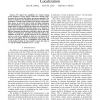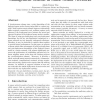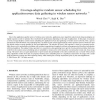CN
2007
13 years 5 months ago
2007
This paper describes BiSNET (Biologically-inspired architecture for Sensor NETworks), a middleware architecture that addresses several key issues in multi-modal wireless sensor ne...
IJSNET
2008
13 years 5 months ago
2008
: Suppose we need to watch a set of targets continuously for a required period of time, and suppose we choose any number of sensors from a fixed set of sensor types and place them ...
IJRR
2008
13 years 5 months ago
2008
We explore the capabilities of a robotic sensing system designed to locate objects underwater through active movement of an electric field emitter and sensor apparatus. The system ...
IJNSEC
2008
13 years 5 months ago
2008
A location-aware scheme uses a priori knowledge of the deployed sensor nodes of some target field in a sensor network. Such location-aware schemes improve substantially higher net...
CORR
2006
Springer
13 years 5 months ago
2006
Springer
Suppose we are given a set of objects that cover a region and a duration associated with each object. Viewing the objects as jobs, can we schedule their beginning times to maximiz...
COMCOM
2006
13 years 5 months ago
2006
Due to the application-specific nature of wireless sensor networks, application-aware algorithm and protocol design paradigms are highly required in order to optimize the overall ...
COMCOM
2006
13 years 5 months ago
2006
Scalability and extended lifetime are two critical design goals of any large scale wireless sensor network. A two-tiered network model has been proposed recently for this purpose....
COMCOM
2006
13 years 5 months ago
2006
In this paper, we focus our attention on the problem of assigning initial secrets to users in ad-hoc network (respectively, sensors in a sensor network) so that they can use those...
COMCOM
2006
13 years 5 months ago
2006
Wireless sensor networks constitute the platform of a broad range of applications related to national security, surveillance, military, health care, and environmental monitoring. ...
CN
2006
13 years 5 months ago
2006
Most fault-tolerant schemes for wireless sensor networks focus on power failures or crash faults. Little attention has been paid to the data inconsistency failures which occur whe...



